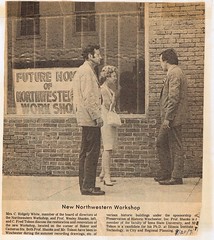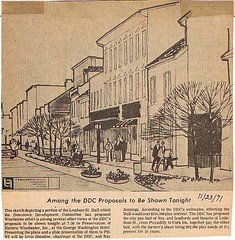 Following the breakthrough after meeting with Winchester City Council to propose better cooperation for preservation, PHW could redirect its efforts into new avenues. The September 16, 1970 PHW meeting reflected this change of pace, with Robert Kern, PHW’s president, suggesting educational efforts for prospective preservationists. One of those programs was a series of educational articles by Lewis Barton and Audrey Coleman to run in the Winchester Star, highlighting historic properties with interesting stories and photographs.
Following the breakthrough after meeting with Winchester City Council to propose better cooperation for preservation, PHW could redirect its efforts into new avenues. The September 16, 1970 PHW meeting reflected this change of pace, with Robert Kern, PHW’s president, suggesting educational efforts for prospective preservationists. One of those programs was a series of educational articles by Lewis Barton and Audrey Coleman to run in the Winchester Star, highlighting historic properties with interesting stories and photographs.
Lectures and expert presenters continued, including B. Powell Harrison and his wife Agnes from Leesburg who encouraged PHW in October 1970 to pursue two keys to success: dedicated members and constantly forging ahead with programs. This program was also one of our first introductions to the idea of a revolving fund, which would soon become central to PHW’s activities.(1)(2)
 The first recorded suggestion of house tours for education and fundraising occurred in June 1970. Nancy Pennypacker offered to conduct a tour of several of the local Hite homes, ending at her home “Spring Hill” for a reception. We can look back with some amusement now at how coolly the suggestion was received: “Some opposition was expressed . . . It was felt that we certainly might enjoy a tour to these homes but that its value as a money-making project was very limited.”
The first recorded suggestion of house tours for education and fundraising occurred in June 1970. Nancy Pennypacker offered to conduct a tour of several of the local Hite homes, ending at her home “Spring Hill” for a reception. We can look back with some amusement now at how coolly the suggestion was received: “Some opposition was expressed . . . It was felt that we certainly might enjoy a tour to these homes but that its value as a money-making project was very limited.”
By far the most eye-opening presentations were slideshows presented by Ray Jennings. As a newcomer to Winchester, he could see the charm and value of Winchester’s buildings, as well as identify areas where improvements could be made. His first recorded presentation to the PHW membership was March 25, 1971, focusing on the interesting details of local buildings that a longtime resident may have overlooked, as well as pointing out problems with commercial signage, neon lights, utility poles, and vast expanses of asphalt parking lots in a historic area. As a member of the Downtown Development Committee, he also led the presentations on the proposed pedestrian mall plans with Irvin Shendow in November 1971.
 In 1972, PHW sponsored a team from the Historic American Building Survey (HABS) to document buildings in Winchester. The team researched, measured and produced scale drawings of Lawyers Row on Rouss Avenue and part of Amherst Street, as well as speaking informally with PHW representatives at other renovation projects.(3)(4) HABS, established in 1933, was part of the Works Progress Administration. The program was conceived as a method of providing work for unemployed architects by documenting historic buildings during the Great Depression. HABS and its sister documentation efforts continue to document resources under the auspices of the National Parks Service, providing valuable hands-on experience primarily for college and graduate students in architecture and historic preservation disciplines.
In 1972, PHW sponsored a team from the Historic American Building Survey (HABS) to document buildings in Winchester. The team researched, measured and produced scale drawings of Lawyers Row on Rouss Avenue and part of Amherst Street, as well as speaking informally with PHW representatives at other renovation projects.(3)(4) HABS, established in 1933, was part of the Works Progress Administration. The program was conceived as a method of providing work for unemployed architects by documenting historic buildings during the Great Depression. HABS and its sister documentation efforts continue to document resources under the auspices of the National Parks Service, providing valuable hands-on experience primarily for college and graduate students in architecture and historic preservation disciplines.
Under all of the educational activities was a sense that PHW needed to do a project to demonstrate how preservation works and benefits the community. Next week, we will investigate the first successful major preservation project spearheaded by the organization.